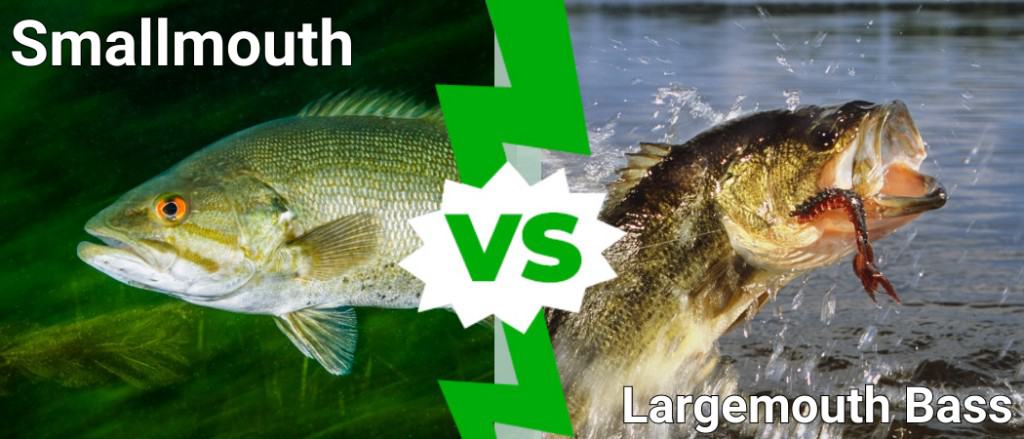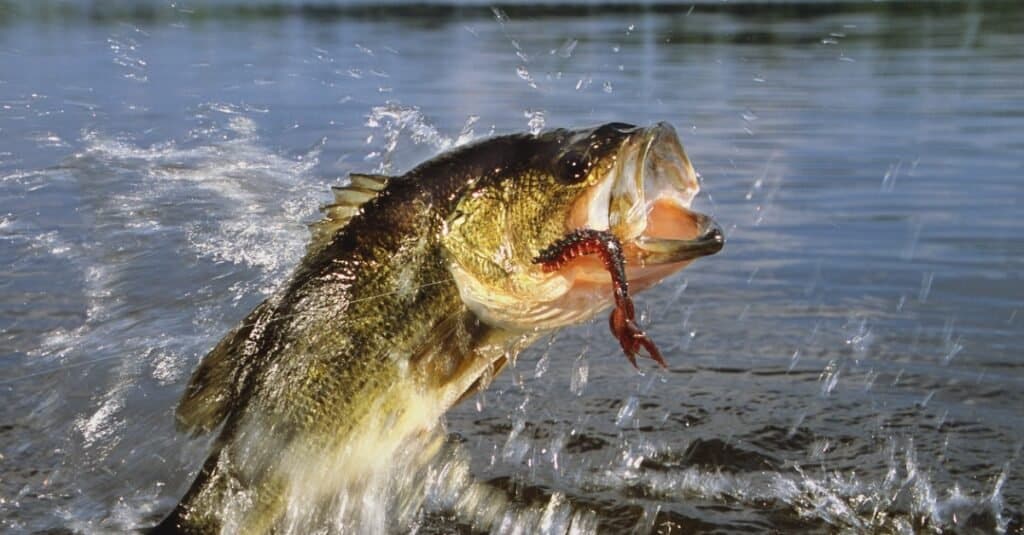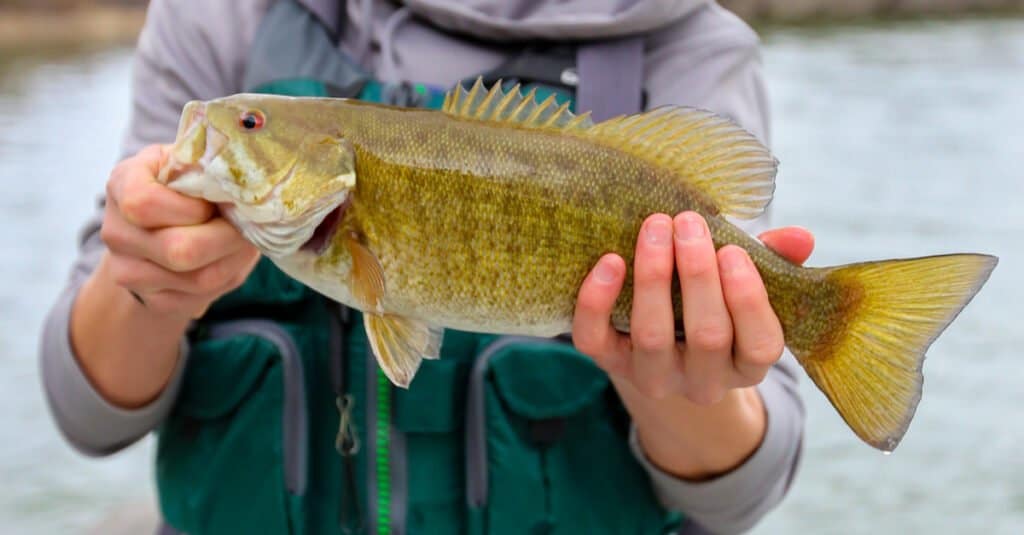If there’s one thing you can count on in Wisconsin, it’s the plentiful fishing. The state is known for its iconic American badger as well as its high-quality cheese and beer. However, with over 15,000 lakes, it also stands out as an angler’s paradise. Anglers have caught some impressive largemouth bass in the course of recorded history. Read on to discover the largest largemouth bass ever caught in Wisconsin!
How Large is the Largest Largemouth Bass Ever Caught in Wisconsin?

The largest largemouth bass ever caught in Wisconsin weighed 11 pounds 3 ounces.
©Ryno Botha/Shutterstock.com
The largest largemouth bass ever caught in Wisconsin weighed in at 11 pounds 3 ounces. According to the Wisconsin Department of Natural Resources, a fisherman caught it at Lake Ripley in Jefferson County on October 12, 1940. Unfortunately, the length and girth were not recorded at the time.
Although Wisconsin has many different species of fish, the largemouth bass stands out as a popular sport fish. This is partly to do with its size, flavor, and fighting spirit.
Where Is Lake Ripley Located on a Map?
Lake Ripley is located to the east of Cambridge and the northeast of CamRock County Park. It is also located to the south of Hope Lake and London.
A Contender for the Title in Wisconsin
The title for the largest largemouth bass ever caught in Wisconsin was almost surpassed in 2012 by a young Wisconsin woman, Gabriella Esperson. While fishing on an unnamed lake in the state, she caught a massive bass. She managed to reel it in after a struggle. When she weighed it on her boat scale, the fish registered at 11.05 pounds, just shy of the record. With an official scale, that number could possibly have gone up.
However, Esperson released the fish back into the lake without taking it to be officially weighed. She based her decision on her desire to allow it to breed and grow. The lake where she caught it is still unknown due to concerns that the discovery would cause it to be overfished.
Largemouth bass are among the fifteen biggest fish in the Great Lakes, a list that includes walleye, lake trout, and the whopping lake sturgeon. Largemouth bass rank at number 12, just below the coho salmon. The abundance of large fish makes Wisconsin a treasure trove for anglers hoping to hook their next big catch.
That being said, overfishing remains a concern for some species. To stimulate population growth, anglers are encouraged to release their catches back into the water if possible. Luckily for largemouth bass, they typically survive catch-and-release.
Other Largemouth Bass Records

In Florida, a man caught a largemouth bass weighing 17.27 pounds.
©Maclane Parker/Shutterstock.com
Wisconsin may have secured itself a big fish, but its state record is by no means the greatest. In Florida, a man named Billy O’Berry caught a largemouth bass weighing 17.27 pounds. The fish measured 30 inches in length with a girth of 22.5 inches.
But even that remarkable catch pales next to the world record set on June 2, 1932, by George Washington Perry. His largemouth bass came in at an unbelievable 22 pounds 4 ounces, almost twice Wisconsin’s record.
The world record is not entirely undisputed. In 2009, a Japanese fisherman named Manabu Kurita caught a largemouth bass weighing 22 pounds 4.96 ounces. Though it was technically larger, it could not be ratified as a world record. For this to happen, it would have had to be at least 2 ounces heavier than the record holder. For that reason, the world record is considered a tie.
How to Identify the Largemouth Bass

The largemouth bass is relatively easy to identify. Its most distinctive trait is the gaping mouth for which it is named. This overlarge mouth works in concert with its gills to create a powerful suction. This process aids it in capturing and eating prey. The lower jaw extends slightly beyond the upper, giving it a mild underbite.
Largemouth bass tend to be greenish-gray with a black stripe extending along both sides to the tail. Females grow to be larger than males and therefore are highly prized. These broad, muscular fish have powerful bodies capable of putting up a fierce fight. This increases their value as a sport fish.
Smallmouth bass are closely related to their large-mouthed cousins, though there are distinct differences. Smallmouth bass, as per their name, are much smaller in the mouth and are usually no more than 10 pounds. While the largemouth bass can grow to 15-30 inches long, smallmouth range between 10-20 inches.
Smallmouth bass also prefer cooler, open waters, while largemouth bass seek warmth and shelter. In addition to these differences, smallmouth are light brown instead of greenish-gray.
What Do Largemouth Bass Eat?

Largemouth bass are carnivorous, eating anything they can physically chew and swallow.
©iStock.com/stammphoto
Bass are carnivorous, eating anything they can physically chew and swallow. For largemouth bass, this opens up possibilities not available to its smaller-mouthed kin. Their diet includes:
- Insects
- Fish
- Crayfish
- Snakes
- Frogs
- Crabs
- Crawfish
- Lizards
- Baby birds
Bass are also occasionally cannibalistic, eating smaller bass if the opportunity presents. They hunt by using the suction created by their mouths and gills. Once this suction is activated, prey find it next to impossible to escape.
Because they eat just about anything, largemouth bass are more likely than many other fish to go for the bait at the end of a hook. This is yet another reason why fishermen prefer them. Governments have introduced largemouth bass as a new species in some parts of the world. Ironically, this has made them unpopular in some regions, as they are aggressive and often take over their adopted habitats. In some places, they are systematically eliminated to preserve the local ecosystem.
Places to Find Largemouth Bass in Wisconsin
Largemouth bass can be found in almost any body of fresh water, including lakes, rivers, streams, and marshes. This makes them ideal for opportunistic fishers as well as for those who have planned a fishing trip in advance. Wisconsin is a hotbed for bodies of fresh water with abundant lakes, some of them impressive in size. Rock Lake, Lake Butte des Morts, and Lake Chippewa, as well as the Great Lakes, all harbor the largemouth bass.
However, for a different experience, fish enthusiasts can visit one of the aquariums in Wisconsin and see their favorite species up close. Centers such as Discovery World showcase the various biomes available in Wisconsin as well as provide visitors with unique experiences they would likely not have access to otherwise.
Are Largemouth Bass Good to Eat?

Largemouth bass are popular sport fish for their size, but smallmouth bass are generally considered better eating.
©CSNafzger/Shutterstock.com
Largemouth bass are listed among the four best Great Lakes fish to eat. This is high praise, considering that the Great Lakes are home to 177 species of fish.
Besides their value as a sport fish, largemouth bass are popular as a dish. However, smallmouth bass are considered to be better yet, with a milder taste and firmer texture. In addition, they respond with greater versatility to various seasonings, making them a cook’s favorite.
The largest largemouth bass ever caught in Wisconsin was 11 pounds 3 ounces. However, as the world record shows, it’s never too late to try hooking the world’s next biggest fish.
The photo featured at the top of this post is © iStock.com/stammphoto
Thank you for reading! Have some feedback for us? Contact the AZ Animals editorial team.






